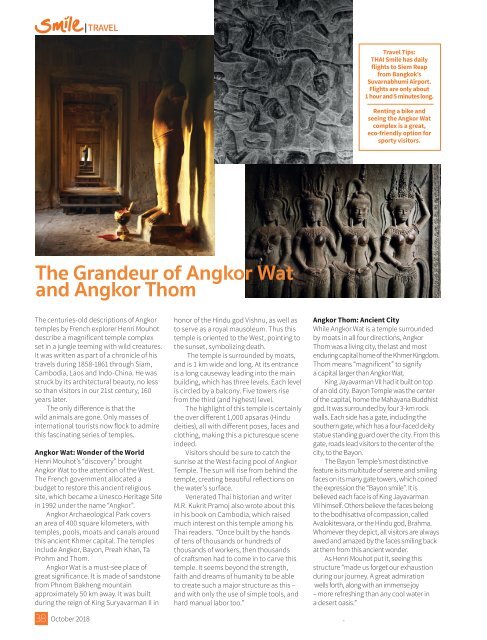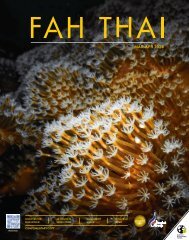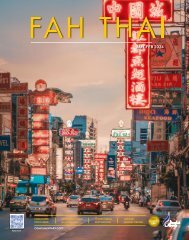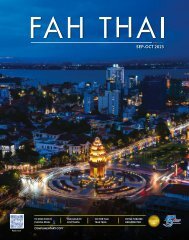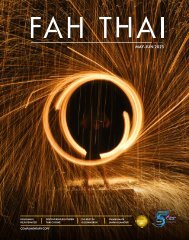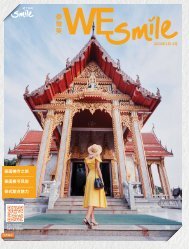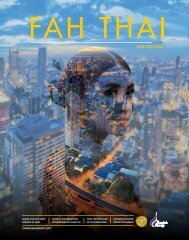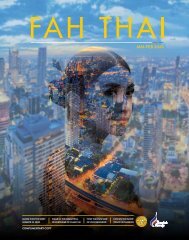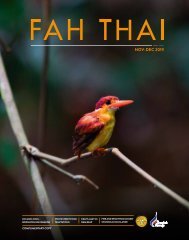Create successful ePaper yourself
Turn your PDF publications into a flip-book with our unique Google optimized e-Paper software.
TRAVEL<br />
Travel Tips:<br />
THAI Smile has daily<br />
flights to Siem Reap<br />
from Bangkok’s<br />
Suvarnabhumi Airport.<br />
Flights are only about<br />
1 hour and 5 minutes long.<br />
Renting a bike and<br />
seeing the Angkor Wat<br />
complex is a great,<br />
eco-friendly option for<br />
sporty visitors.<br />
The Grandeur of Angkor Wat<br />
and Angkor Thom<br />
The centuries-old descriptions of Angkor<br />
temples by French explorer Henri Mouhot<br />
describe a magnificent temple complex<br />
set in a jungle teeming with wild creatures.<br />
It was written as part of a chronicle of his<br />
travels during 1858-1861 through Siam,<br />
Cambodia, Laos and Indo-China. He was<br />
struck by its architectural beauty, no less<br />
so than visitors in our 21st century, 160<br />
years later.<br />
The only difference is that the<br />
wild animals are gone. Only masses of<br />
international tourists now flock to admire<br />
this fascinating series of temples.<br />
Angkor Wat: Wonder of the World<br />
Henri Mouhot’s “discovery” brought<br />
Angkor Wat to the attention of the West.<br />
The French government allocated a<br />
budget to restore this ancient religious<br />
site, which became a Unesco Heritage Site<br />
in 1992 under the name “Angkor”.<br />
Angkor Archaeological Park covers<br />
an area of 400 square kilometers, with<br />
temples, pools, moats and canals around<br />
this ancient Khmer capital. The temples<br />
include Angkor, Bayon, Preah Khan, Ta<br />
Prohm and Thom.<br />
Angkor Wat is a must-see place of<br />
great significance. It is made of sandstone<br />
from Phnom Bakheng mountain<br />
approximately 50 km away. It was built<br />
during the reign of King Suryavarman II in<br />
38<br />
<strong>October</strong> <strong>2018</strong><br />
honor of the Hindu god Vishnu, as well as<br />
to serve as a royal mausoleum. Thus this<br />
temple is oriented to the West, pointing to<br />
the sunset, symbolizing death.<br />
The temple is surrounded by moats,<br />
and is 1 km wide and long. At its entrance<br />
is a long causeway leading into the main<br />
building, which has three levels. Each level<br />
is circled by a balcony. Five towers rise<br />
from the third (and highest) level.<br />
The highlight of this temple is certainly<br />
the over different 1,000 apsaras (Hindu<br />
deities), all with different poses, faces and<br />
clothing, making this a picturesque scene<br />
indeed.<br />
Visitors should be sure to catch the<br />
sunrise at the West-facing pool of Angkor<br />
Temple. The sun will rise from behind the<br />
temple, creating beautiful reflections on<br />
the water’s surface.<br />
Venerated Thai historian and writer<br />
M.R. Kukrit Pramoj also wrote about this<br />
in his book on Cambodia, which raised<br />
much interest on this temple among his<br />
Thai readers. “Once built by the hands<br />
of tens of thousands or hundreds of<br />
thousands of workers, then thousands<br />
of craftsmen had to come in to carve this<br />
temple. It seems beyond the strength,<br />
faith and dreams of humanity to be able<br />
to create such a major structure as this –<br />
and with only the use of simple tools, and<br />
hard manual labor too.”<br />
Angkor Thom: Ancient City<br />
While Angkor Wat is a temple surrounded<br />
by moats in all four directions, Angkor<br />
Thom was a living city, the last and most<br />
enduring capital home of the Khmer Kingdom.<br />
Thom means “magnificent” to signify<br />
a capital larger than Angkor Wat.<br />
King Jayavarman VII had it built on top<br />
of an old city. Bayon Temple was the center<br />
of the capital, home the Mahayana Buddhist<br />
god. It was surrounded by four 3-km rock<br />
walls. Each side has a gate, including the<br />
southern gate, which has a four-faced deity<br />
statue standing guard over the city. From this<br />
gate, roads lead visitors to the center of the<br />
city, to the Bayon.<br />
The Bayon Temple’s most distinctive<br />
feature is its multitude of serene and smiling<br />
faces on its many gate towers, which coined<br />
the expression the “Bayon smile”. It is<br />
believed each face is of King Jayavarman<br />
VII himself. Others believe the faces belong<br />
to the bodhisattva of compassion, called<br />
Avalokitesvara, or the Hindu god, Brahma.<br />
Whomever they depict, all visitors are always<br />
awed and amazed by the faces smiling back<br />
at them from this ancient wonder.<br />
As Henri Mouhot put it, seeing this<br />
structure “made us forget our exhaustion<br />
during our journey. A great admiration<br />
wells forth, along with an immense joy<br />
– more refreshing than any cool water in<br />
a desert oasis.”<br />
-


